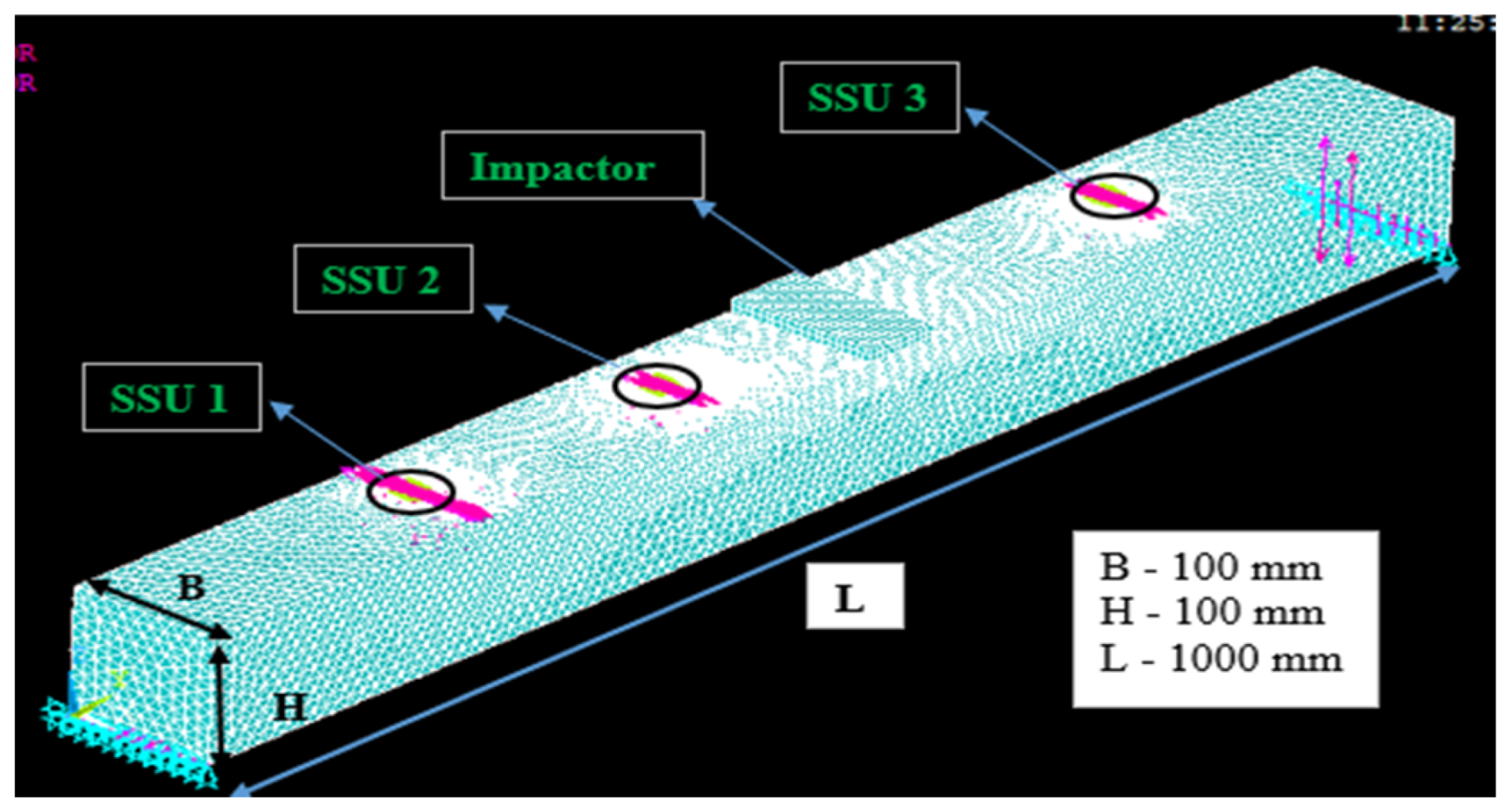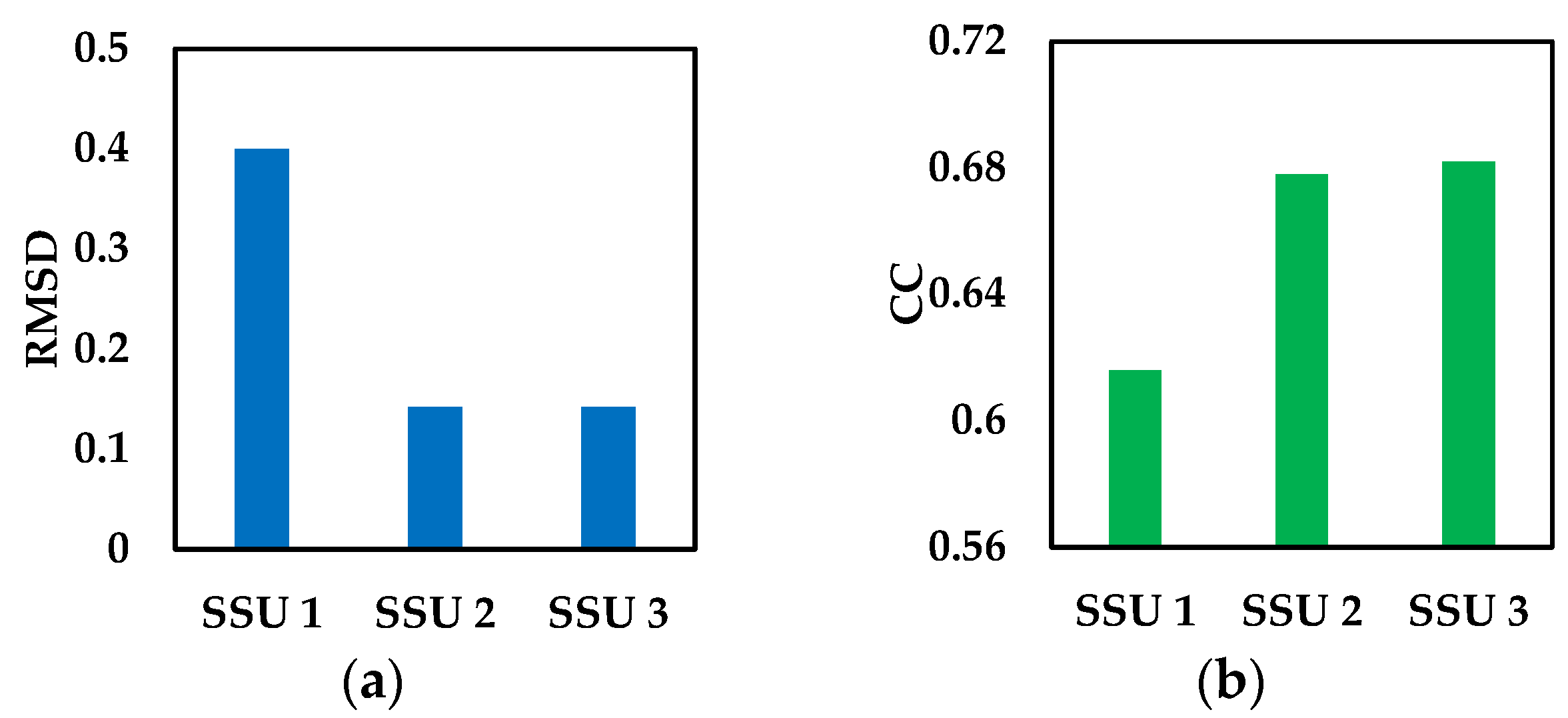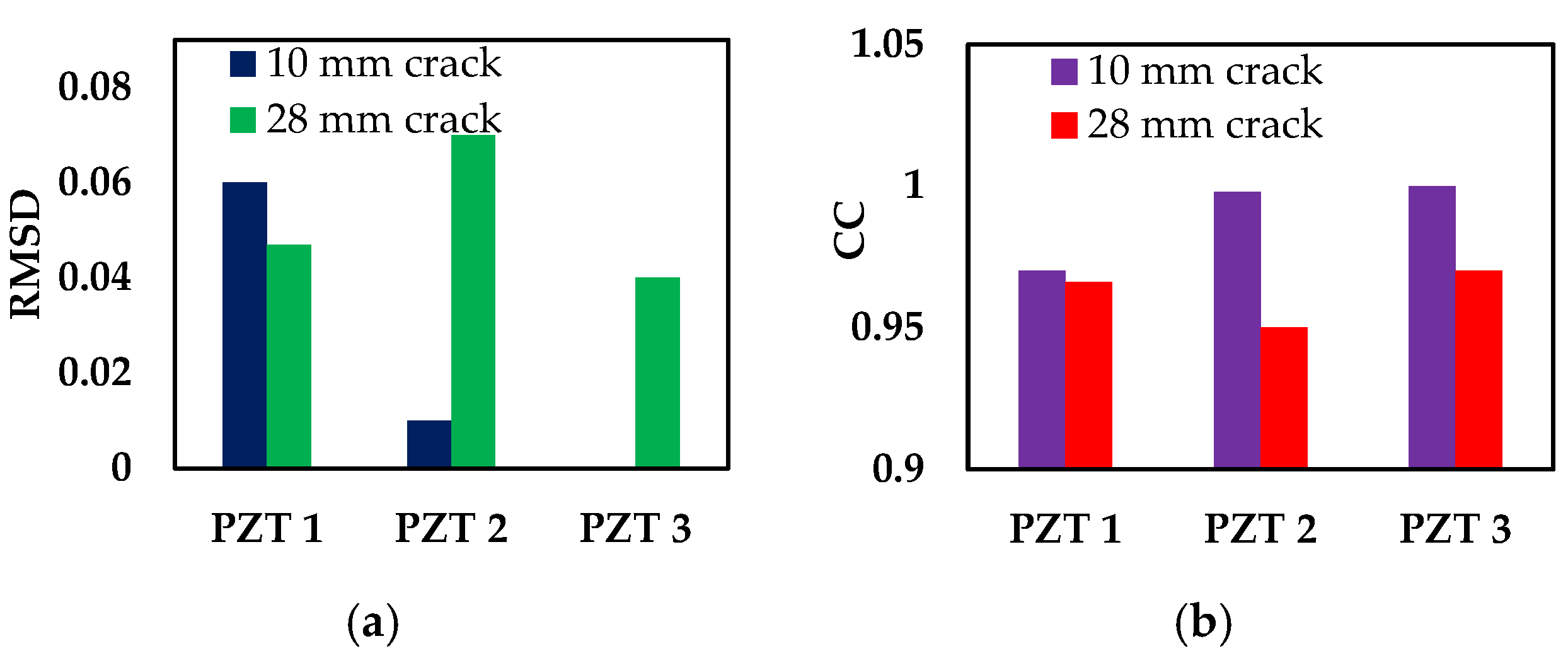Surface-Mounted Smart PZT Sensors for Monitoring Damage Using EMI-Based Multi-Sensing Technique †
Abstract
:1. Introduction
2. Methodology and Investigation
2.1. Introduction of Smart Sensing Units (SSUs)
2.2. Investigation of the Concrete Beam with Multiple SSUs
2.2.1. Methodology for Structural Damage Detection
2.2.2. Methodology for Structural Damage Localization
3. Results and Discussion
3.1. Detecting Structural Damage
3.2. Localizing the Structural Damage
4. Experimental Validation
5. Conclusions
Supplementary Materials
Author Contributions
Funding
Institutional Review Board Statement
Informed Consent Statement
Data Availability Statement
Conflicts of Interest
References
- Saravanan, T.J.; Gopalakrishnan, N.; Rao, N.P. Damage detection in structural element through propagating waves using radially weighted and factored RMS. Measurement 2015, 73, 520–538. [Google Scholar] [CrossRef]
- Lim, Y.Y.; Bhalla, S.; Soh, C.K. Structural identification and damage diagnosis using self-sensing piezo-impedance transducers. Smart Mater. Struct. 2006, 15, 987. [Google Scholar] [CrossRef]
- Annamdas, V.G.M.; Soh, C.K. Three-dimensional electro-mechanical impedance model. II: Damage analysis and PZT characterization. J. Aerosp. Eng. 2007, 20, 63–71. [Google Scholar] [CrossRef]
- Saravanan, T.J.; Balamonica, K.; Priya, C.B.; Reddy, A.L.; Gopalakrishnan, N. Comparative performance of various smart aggregates during strength gain and damage states of concrete. Smart Mater. Struct. 2015, 24, 085016. [Google Scholar] [CrossRef]
- Saravanan, T.J.; Balamonica, K.; Priya, C.B.; Gopalakrishnan, N.; Murthy, S.G.N. Piezoelectric EMI–based monitoring of early strength gain in concrete and damage detection in structural components. J. Infrastruct. Syst. 2017, 23, 04017029. [Google Scholar] [CrossRef]
- Saravanan, T.J.; Balamonica, K.; Priya, C.B.; Gopalakrishnan, N.; Murthy, S.G.N. Non-destructive piezo electric based monitoring of strength gain in concrete using smart aggregate. In Proceedings of the International Symposium Non-Destructive Testing in Civil Engineering (NDT-CE), Berlin, Germany, 5–17 September 2015; pp. 15–17. [Google Scholar]
- Bhalla, S.; Kumar, P.; Gupta, A.; Datta, T.K. Simplified Impedance Model for Adhesively Bonded Piezo-Impedance Transducers. J. Aerosp. Eng. 2009, 22, 373–382. [Google Scholar] [CrossRef] [Green Version]
- Yang, Y.; Hu, Y.; Lu, Y. Sensitivity of PZT impedance sensors for damage detection of concrete structures. Sensors 2008, 8, 327–346. [Google Scholar] [CrossRef] [PubMed] [Green Version]
- Wang, D.; Song, H.; Zhu, H. Numerical and experimental studies on damage detection of a concrete beam based on PZT admittances and correlation coefficient. Constr. Build. Mater. 2013, 49, 564–574. [Google Scholar] [CrossRef]
- Wang, T.; Tan, B.; Lu, M.; Zhang, Z.; Lu, G. Piezoelectric Electro-Mechanical Impedance (EMI) Based Structural Crack Monitoring. Appl. Sci. 2020, 10, 4648. [Google Scholar] [CrossRef]
- Balamonica, K.; Saravanan, T.J.; Priya, C.B.; Gopalakrishnan, N. Piezoelectric sensor-based damage progression in concrete through serial/parallel multi-sensing technique. Struct. Health Monit. 2020, 19, 339–356. [Google Scholar]
- Saravanan, T.J.; Gopalakrishnan, N.; Priya, C.B. Monitoring of early-age characteristics of concrete using EMI based embedded PZT transducers on varying plate thickness. Constr. Mater. Syst. 2017, 557–566. [Google Scholar]
- Priya, C.B.; Saravanan, T.J.; Balamonica, K.; Gopalakrishnan, N.; Rao, A.R.M. EMI-based monitoring of early-age characteristics of concrete and comparison of serial/parallel multi-sensing technique. Constr. Build. Mater. 2018, 191, 1268–1284. [Google Scholar] [CrossRef]








| SSU No. | 1 | 2 | 3 |
|---|---|---|---|
| Thickness (mm) | 0.75 | 1.5 | 3 |
| Resonant frequency (kHz) | 335 | 350 | 355 |
| SSU No. | 1 | 2 | 3 |
|---|---|---|---|
| Distance from impactor (mm) | 310 | 110 | 250 |
| Distance from crack location (mm) | 70 | 120 | 480 |
Publisher’s Note: MDPI stays neutral with regard to jurisdictional claims in published maps and institutional affiliations. |
© 2021 by the authors. Licensee MDPI, Basel, Switzerland. This article is an open access article distributed under the terms and conditions of the Creative Commons Attribution (CC BY) license (https://creativecommons.org/licenses/by/4.0/).
Share and Cite
Parpe, A.; Saravanan, T.J. Surface-Mounted Smart PZT Sensors for Monitoring Damage Using EMI-Based Multi-Sensing Technique. Eng. Proc. 2021, 10, 51. https://doi.org/10.3390/ecsa-8-11254
Parpe A, Saravanan TJ. Surface-Mounted Smart PZT Sensors for Monitoring Damage Using EMI-Based Multi-Sensing Technique. Engineering Proceedings. 2021; 10(1):51. https://doi.org/10.3390/ecsa-8-11254
Chicago/Turabian StyleParpe, Aditya, and Thiyagarajan Jothi Saravanan. 2021. "Surface-Mounted Smart PZT Sensors for Monitoring Damage Using EMI-Based Multi-Sensing Technique" Engineering Proceedings 10, no. 1: 51. https://doi.org/10.3390/ecsa-8-11254
APA StyleParpe, A., & Saravanan, T. J. (2021). Surface-Mounted Smart PZT Sensors for Monitoring Damage Using EMI-Based Multi-Sensing Technique. Engineering Proceedings, 10(1), 51. https://doi.org/10.3390/ecsa-8-11254






